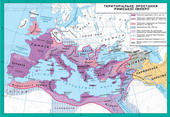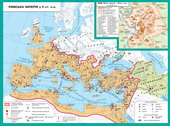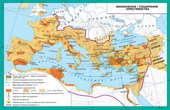§ 51. Roman culture
1. Culture of the republic
On the formation and development of culture of the Roman Republic had a big impactGreeks, especially after the unification of Italy under the rule of Rome and capture himGreek colonies in southern Apennine peninsula. The Romans always interestedachievements of different nations could be practically applied inagriculture, construction, marine and military affairs, so gainsGreek civilization sparked huge interest among citizens of the RomanRepublic.
Education. The first steps in education was the Romans family education. Children brought up inrespect for the beliefs and customs of ancestors. They were undoubtedly will obeyfather. It was believed that a true citizen - a son and obedient disciplinedwarrior. Typically, violation of parental liberty was severely punished.
The next step in attaining knowledge was the school. In the days of the Roman Republicschools studied the so-called seven liberal arts: grammar, logic, rhetoric,geometry, arithmetic, astronomy, music. Subsequently they added the architecture.
There were three types of schools: primary, grammar and rhetoric. The elementary schoolstudied children aged 7 to 12 years. They acquire, Readingand counting. Learn to write, it was easy because the words written the way theysounded. If a student missed at least one letter in the word, beat him beaten.Writing is not valued beauty and speed. The girls also went to school andstudied even more subjects than boys.
In Grammar school boys 12-16 yearsstudied Greek and Roman literature, Latin and Greek.
High school can be considered rhetorical, where young people 16-20 years studied philosophy,history, rhetoric and law. Like the Greeks, were private schools, tuitionhad to pay. Prestigious considered studying in Athens or on the islandRhodes.
Scientific knowledge. Contemporary knowledge of medicine, continuing the Greek scientifictradition, summarized Avl Cornelius Celsius (I cent.BC) in a work on medicine. "
Philosopher Titus LukretsiyCa (95-1955 BC)in his book "On the nature of things" doctrine outlined Greek thinker EpicurusWho denied the existence of gods. The main ideaswork was the idea of death the soul, the nature of the independence of the will of the godsabout the infinite universe. Titus Lukretsiy First Cadivided the history of mankind on stone, copper and iron ages. But the ultimatecontribution to world science did treasury of the Romans that created a newdirection in scientific knowledge - jurisprudence. His "father" called Hneya Flavia (VI century BC.). У Article II. BC appearedfirst treatises on law. In times of decline of the republic, when the laws are oftencanceled, amended or varied, it became necessary to inform aboutthese changes are citizens. Since the time of Julius Caesar on the central area of exposed board"The daily data of the Roman People", which placed anmilitary victory and content of new laws. Copies were sending in all of Romeprovince. This board can be considered praschurkoyu modern newspapers.
Literature and theater. Native Latin for the Romans because of the Romanachievements into a language of interethnic communication in the ancientworld. It became the basis for the emergence of modern languages: Italian,English, Spanish, French. Latin has long been the language of science,and in medicine remained till today. Known is the latin cruiseexpressions: "Carthage must be destroyed," came, saw, conquered and manyothers. Latin were written the best works of Roman authors.
Roman literature emerged from the records transfers and myths in III. BC One of itsfounders was Livy Andronicus (? -
бл. 204 was BC) whichtranslated the Latin "Odyssey." Literature Romans aimed to educatecitizen and patriot. But the Romans liked to have fun and so populargenre was comedy. Father of comedy is Titus Maktsiy Plavt (250
- бл. 184 was BC) whichwrote favorite poetical works Latins "pot", "Donkey," "boastfulWarrior ", which ridiculed the Greek copycat designs.
Real life comedy began when she put on stage. 240 was BCThe first performance took place in Latin. This is considered the beginning of the Romantheater.
The founder of Roman prose believe MarkPorcius Cato (234-149 years BC).He is one of the first works of prose literature of therepublic, which survived in its entirety. It is dedicated to agriculture andcontains useful tips farmers, but also sings and rural lifestylespeasants. That farmers, according to Cato, become the strongest and most daringsoldiers. Work Cato "Home" was the first statement of the history of Rome.
Architecture. Developing the art of architecture, the Romans largely followedGreeks, but went away from their teachers. In architecture the Romans combinedEtruscan and Greek traditions and oriental elements added. They diversifybuilding materials. It was the Romans began to use strong Connectioncalcareous mud invented concrete, which is widely used to Article II. BC In constructionRomans widely used arch, vdoskonalyvshy it. This Arc constructioncould stand on a few floors. Implementing call "bread and circuses!", Incities built theaters, where seats for spectators were located semicircle.Erected circuses, where organized racing chariots. The Romans were the first tobuild the amphitheater for the cruel spectacle - gladiatorial fights, persecutionwild animals, and Basilica - large indoor hall for a meeting.
2. Culture of empire
Education. Unlike the days of the Republic, when most schools wereprivate, the empire began to control the education system. Teachers were stateemployees and receive wages. Number of teachers depended on the sizecity and therefore the number of students. In IV. BC all who wanted to teach,had to get permission of the emperor. Considerable support was given to schoolswealthy people, including emperors. Greek continued to operate centersscholarship: Athenian Academy and Likey, SchoolAlexandria, Egypt.
Scientific knowledge. The contribution to the development of various branches of scientific knowledge madePliny the Elder (23 (24)-1979) His most famous workis the product of "natural history" in connection with the conquest by the Romans newdeveloped land geography. Known is the work "Geography", which belongsPeru Strabon. He collected in his book all availableAt that time information about the countries and peoples - from Britain to India.
In the world treasury includes works ClaudiaPtolemy (бл. 90 - бл. 160 years).He compiled astronomical observations and developed a model of the world. Ptolemy believed that the center of the universe is planet Earthwhich has the shape of balls. Around it, scientists believe the Sun and rotating differentplanet. His views were widespread in Europe for manycenturies.
Imperial Rome could be proud of its lawyers. Formed LegalSchools - Sabinianska and Prokulianska,mentioned the names of outstanding scientists and Sabina Prokula.Many efforts have been devoted to devices of the state. Among the most interesting were theLabor Tsytserosh (106-43 BC) and Polibiya (бл. 200 - бл. 120 pp. BC) in which theycontemplated on the advantages and disadvantages of the republican system. Among Romanphilosophers occupied a prominent place Lucius Anne Seneca (бл. 4 p BC– 1965) He wasNero educator and political activist. But the emperor, philosopher zapidozryvshythe plot, made him commit suicide. Seneca developed doctrineof dignity and self respect man. He argued that these qualities canservant to raise up on free, over the poor rich. Special attention is paid philosophermatter of overcoming fear of death, the moral equality of people, existencefate. Seneca Teaching is sometimes considered one of the sources of Christianethics.
The Romans treated carefully as our state and its history.Historical science, by which we know the history of Rome to the smallest details,reached its heyday in the same period of the empire. Historians have often become peoplewho occupied a high social status and were well aware of developments incountry and abroad. Sometimes historians were even emperors. Yes, JuliusCaesar wrote the piece "Notes on the Gallic War. Almost the only source forstudy of early history are works TitusLivia (59 BC - 1917BC). He left descendants work "History of Rome from the founding of the city.
Historian Plutarch (46-120's) so deeply knowGreek and Roman past that first decided to compare lifeactivities, achievements and setbacks most famous statesmen. In"Comparative biography" he told AlexandraMacedonian and Caesar, Demosthenes and Cicero et al.
The height of the Roman historical thought see "History" and "Annals" Tatsita (бл. 58 –
бл. 117 p.). In his writings hespoke about the history of Rome during the empire of barbarian tribes, whichRome fought at that time.
Literature. The famous poet of ancient Rome was Maroon Publius Virgil (70-1919 BC). "Aeneid""Poem about farming," the shepherds song - it works that glorifiedartist. In them he magnifies the Roman Empire and the courage, generosity of its citizens."Aeneid" told of Aeneas - son of Anhiza andthe goddess Venus, one of the defenders of Troy. The plot of "Aeneid" is not timeused in his works writers and poets, including IPKotlyarevsky.
Publius Ovid Nazon (1943BC - бл. 1918BC) in "Metamorphosis" is about the transformation of people and gods inAnimals and constellation "Fast"- The Roman religiousholiday, forgotten by his contemporaries. Ovid believed that the best of times - "golden age"- Have already passed, but before they can return if live as long and shepherdsfarmers. Similarly, praised the "golden age" Quint Horatio Flakk (65-8 years BC), but, unlike Ovid, consideredthat the best time in the future will bring divine savior.
Architecture. In the days of the empire was flourishing architecture. Each emperor triedbeautify the capital city and other magnificent buildings - theaters, an amphitheater,basil, forums or terms. The largest were the terms of the emperor Diocletian, Which could simultaneously accommodate 3200those terms and KarakallyWhere rested to 1800persons. In addition to the baths in thermal oblashtovuvaly room for sports and gymnastics,facilities for recreation, conversations, space for performances speakers, swimming pools,library, courtyard with a small park.
Terme Karakally had a square shape. The centerone-storied terrace housed the main building. There were poolcold water, central hall, lobby, swimming pool with hot water. Onperimeter placed individual baths. Under them at ground level oblashtovuvalycommercial premises, which could come only from the street. For termneed much water, and it served here by an aqueduct. Aqueduct, whichsaturated with water, a huge city, had roughly 440 km. Water forpidihrivalasya term in boilers located in the basement, and a pair of heated floor.Decorated with mosaics and sculptures terms.
Among the luxury palaces of distinguished "Golden House" of Nero. In the throne roomstood a golden statue of the emperor. Complex and quirky design had a ceiling.Movable plates from which it consisted, in effect invoked specialmechanisms, and visitors can see the ceiling of change patterns. The most famousamphitheater was the Colosseum. It could accommodate 50 000 spectators.At the same time in his arena could fight gladiators 2000. In undergroundpremises located gyms, cages for animals, Hospital forwounded.
Grand piece of Roman architecture was the Pantheon - a temple in honor of allgods. It was built in 118-125 years by the architect Apollodora Damascus. Pantheon - round the temple.Its dome in diameter reaches 43 m.Inside it was decorated with white and brown marble.
The Romans became famous for building roads. In the days of the empire they built 372.The length of the ways was more than 80 thousand km. About 30 roads convergein Rome. Therefore, the wording appeared "All roads lead to Rome." Roads built withhewn stone, gravel, stone tiles that are laid out in layers. Even theresigns that are reported, where the distance from Rome is a traveler.The most famous was "Appian road. She is connectingRome with Kapu and extending to 330 km.Achieving the Roman bridge builders is Trajan (98-117 years) through Danube.
Fine arts. If Greek sculpture became famous firstgeneralized character, who put human beauty, in Rome, a significantdevelopment of the genre has acquired a psychological portrait sculpture. Graphic "revived"history, leaving its portrait gallery of the main actors: Julius Caesar,Cicero, Octavian and others.
Mosaic and fresco painting - realistic, with rich colors,displaying volume and deep space - became known after the excavation of citiesPompeii andHerculaneumDestroyed duringeruption of Vesuvius in 1979 BC This tragedy, which brought deathpeople kept living work of art. On the portrait of those timeswith archaeological artefacts found in Fayumskiy oasis inEgypt. Portraits were found in graves. Written on the boards (sometimes - tissues)based on a wax portraits of amazing grace and skilltransfer not only appearance, but the inward man.
Theater. The emergence of Dramatic Art in Rome on the feast of harvest.Roman distinctive theatrical genre were mimes - domestic comic sketchesof dialogue, singing, music and dance (original prototype of the modernOperetta). Then put the comedy and tragedy on the Greek model. Roman actorscame from among the freedman or slave. They usually satlow social status. In Rome, the first having professional actorscorpses and small (for a small number of viewers) the performances.
Concept andterms
Basilica - Buildinghaving checked out a rectangle shape and divided along lines of columns.
Aqueduct – Bridgingconstruction of water pipes for transfer of the obstacles.
Questions and Tasks
1. Compare the achievements of Roman culture during the period Republic and Empire.
2. Describe Roman terms.
3. What distinguished Roman architectural masterpieces – Coliseum and Pantheon?
4. Prove that the Romans used cultural achievements of ancientGreeks.
 English
English





















